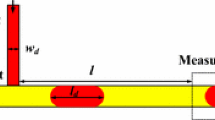Abstract
The study deals with a microfluidic method to investigate the transient behavior of microcapsules in flow. The technique consists of investigating ovalbumin microcapsules passing through a convergent–divergent microchannel made of PolyDiMethylSiloxane. We work with three types of square microchannel with, respectively, cross section values of h × h = 30 × 30, 50 × 50 and 70 × 70 μm. The microchannels length is L = 3h. We analyze the kinetics of deformation of the microcapsules in the microchannels for velocity ranging from 2 to 5 cm/s and for microcapsule size ratio d/h ranging from 0.9 to 2.5. The relaxation process at the pore outlet is modeled using an exponential relaxation law. We show that that the relaxation time at the divergent outlet depends on the microcapsule size ratio d/h. Thanks to the analytical expression of the relaxation, we extract a shear modulus of the membrane equal to 0.04 N/m. This value is consistent with the value of 0.07 N/m that we found using the steady state analysis performed in cylindrical glass capillaries. Thus, it is interesting to notice that the microcapsule behavior based on a simple analytical model can be successfully described despite the complex flow situation consisting of deformable microcapsule in confined square microchannels.










Similar content being viewed by others
References
Andry MC, Edwards-Lévy F, Lévy MC (1996) Free amino group content of serum albumin microcapsules.iii. a study at low ph values. Int J Pharm 128:197
Barthès-Biesel D, Rallison JM (1981) The time-dependent deformation of a capsule freely suspended in a linear shear flow. J Fluid Mech 113:251–267
Carin M, Barthès-Biesel D, Edwards-Lévy F, Postel C, Andrei D (2003) Compression of biocompatible liquid filled hsa-alginate capsules: determination of the membrane mechanical properties. Biotechnol Bioeng 82:207
Chambina O, Voilleya A, Gharsallaoui A, Roudauta G, Saurela R (2007) Applications of spray-drying in microencapsulation of food ingredients: an overview. Food Res Int 40:1107–1121
Chang KS, Olbricht WL (1993) Experimental studies of the deformation and breakup of a synthetic capsule in steady and unsteady simple shear flow. J Fluid Mech 250:609–633
Chang T (2005) Therapeutic applications of polymeric artificial cells. Nat Rev 4:221
Chu TX, Salsac A-V, Leclerc E, Barthès-Biesel D, Wurtz H, Edwards-Lévy F (2010) Comparison between measurements of elasticity and free amino group content of ovalbumin microcapsule membranes: discrimination of the cross-linking degree. J Colloid Interface Sci 355:81–88
Fairhurst D, Loxley A (1954) Micro- and nanoencapsulation of water- and oil-soluble actives for cosmetic and pharmaceutical applications. Particle Sciences Inc., Bethlehem
Fery A, Weinkamer R (2007) Mechanical properties of micro- and nanocapsules: single capsule measurements. Polymer 48:7221–7235
Feng WW, Yang WH (1973) On the contact problem of an inflated spherical nonlinear membrane. J Appl Mech 40:209–214
Gombotz WR, Wee S (1998) Protein release from alginate matrices. Adv Drug Deliv Rev 31:267
Hochmuth RM (2000) Micropipette aspiration of living cells (review). J Biomech 33:15–22
Lardner TJ, Pujara P (1980) Compression of spherical cells. Mech Today 5:161–176
Lefebvre Y, Barthès-Biesel D (2007) Motion of a capsule in a cylindrical tube: effect of membrane pre-stress. J Fluid Mech 589:157–181
Lefebvre Y, Leclerc E, Barthès-Biesel DD, Walter J, Edwards-Lévy F (2008) Flow of artificial microcapsules in microfluidic channels: a method for determining the elastic properties of the membrane. Phys Fluids 20:123102–123112
Orivea G, Hernndeza R, Castroa M, Murua A, Portero A, Pedraz JL (2008) Cell microencapsulation technology: towards clinical application. J Controlled Release 138:76–83
Quéguiner C, Barthès-Biesel D (1997) Axisymmetric motion of capsules through cylindrical channels. J Fluid Mech 348:349–376
Rachik M, D. Barthès-Biesel D, Carin M, Edwards-Lévy F (2006) Identification of the elastic properties of an artificial capsule membrane with the compression test : effect of thickness. J Colloid Interface Sci 301:217
Risso F, Carin M (2004) Compression of a capsule: mechanical laws of membranes with negligible bending stiffness. Phys Rev E 69:061601–061608
Risso F, Colle-Paillot F, Zagzoule M (2006) Experimental investigation of a bioartificial capsule flowing in a narrow tube. J Fluid Mech 547:149–173
Walter A, Rehage H, Leonhard H (2001) Shear induced deformation of microcapsules: shape oscillations and membrane folding. Colloids Surf A: Physicochem Eng Aspects 183–185:123–132
Acknowledgments
This work was supported by the Conseil Régional de Picardie (projects μFIEC and MODCAP). The experimental work was performed in collaboration with Pr. Teruo Fujii research group (French-Japanese SAKURA grant). We thank Florence Edwards Levy from University of Reims who provided the microcapsules used in this study. We also thank Takuji Okamoto for the microchips fabrication and Pr. Marie Oshima (IIS, University of Tokyo) who provided the high speed phantom camera.
Author information
Authors and Affiliations
Corresponding author
Rights and permissions
About this article
Cite this article
Leclerc, E., Kinoshita, H., Fujii, T. et al. Transient flow of microcapsules through convergent–divergent microchannels. Microfluid Nanofluid 12, 761–770 (2012). https://doi.org/10.1007/s10404-011-0907-1
Received:
Accepted:
Published:
Issue Date:
DOI: https://doi.org/10.1007/s10404-011-0907-1




